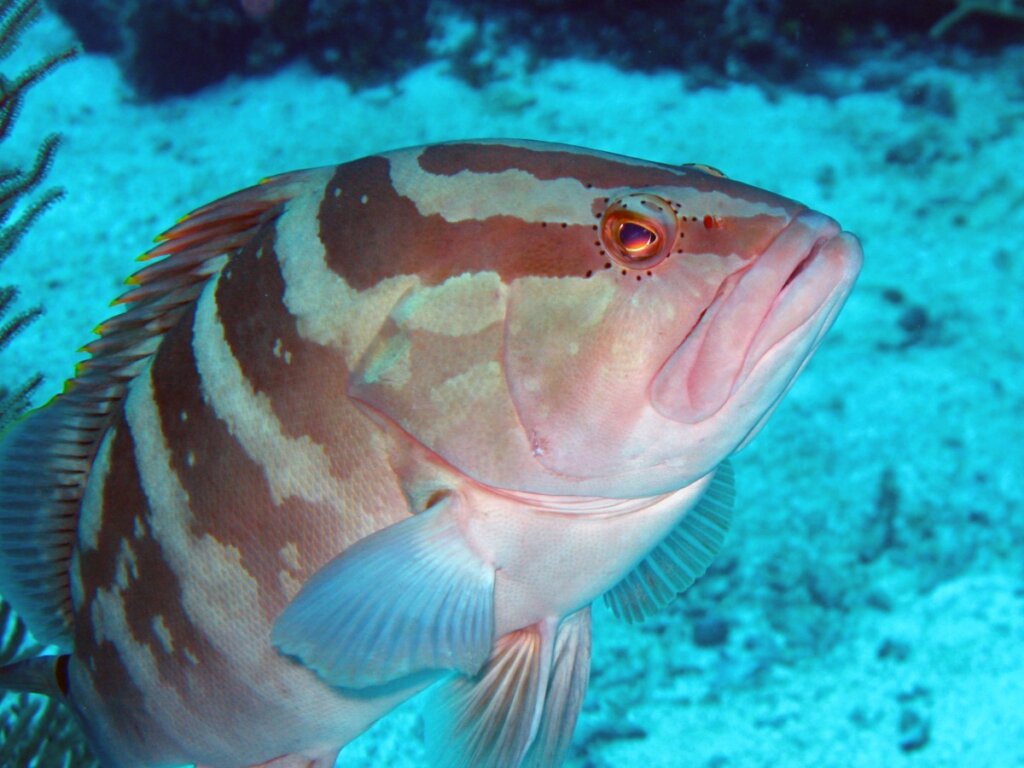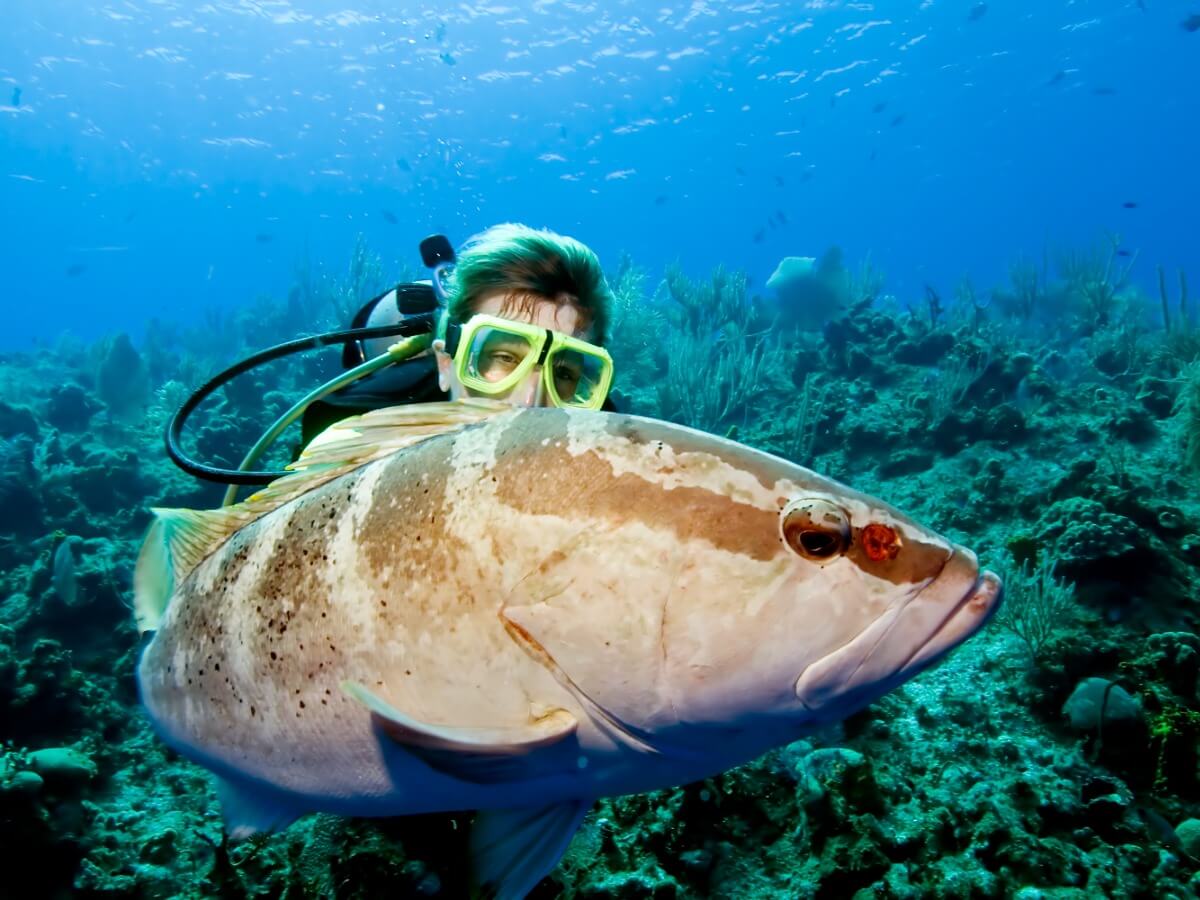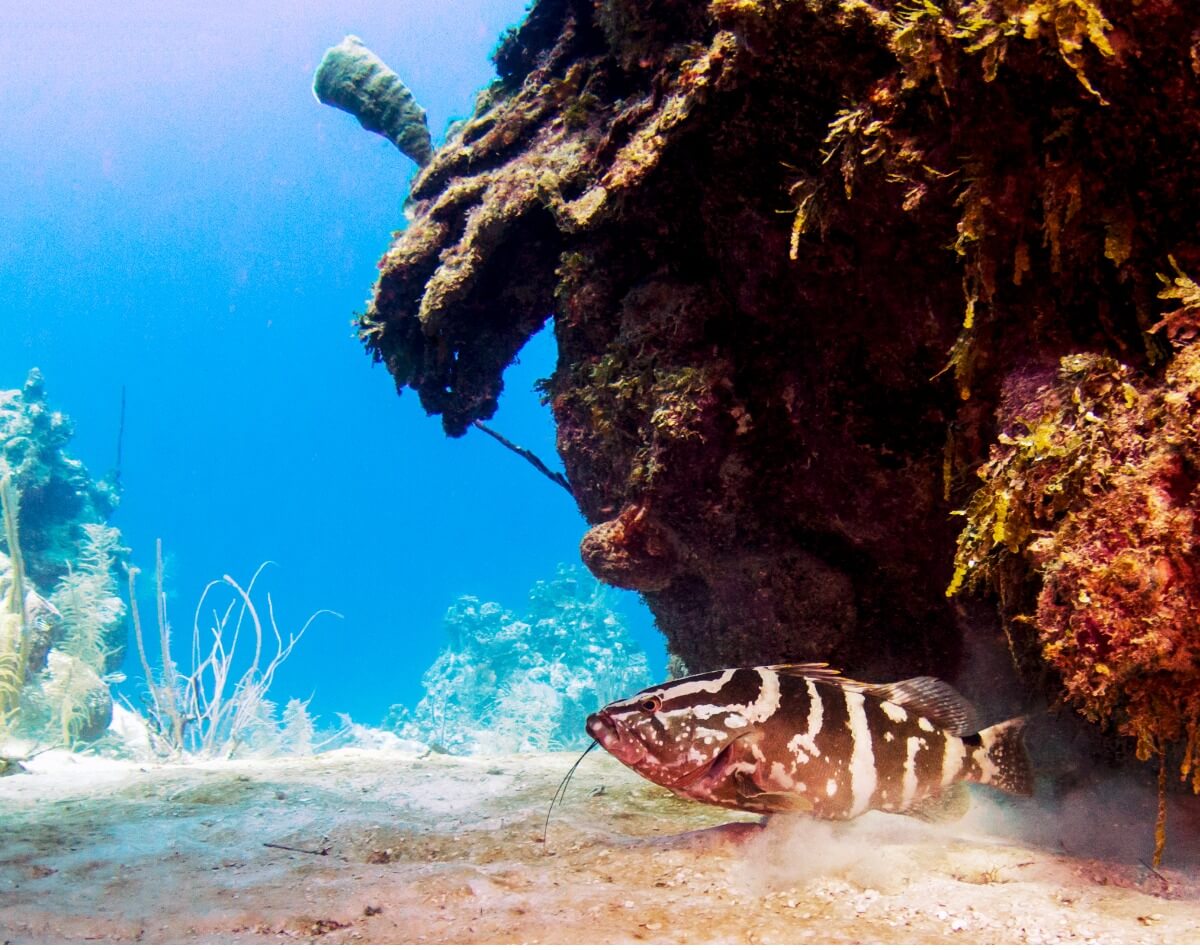The Golden-Striped Grouper: Habitat and Characteristics

The golden-striped grouper (Epinephelus striatus) is a common commercially exploited fish, found on several coral reefs. It belongs to the Serranidae family, one of the most extensive and distributed in marine waters. This species was once considered one of the most abundant in the world, although it’s now critically endangered.
It’s a predator that actively competes against barracudas, sharks, and other fish. Thanks to the diversity in its coloration and its economic importance, it has been an important pillar for the fishing industry. However, it currently faces risks that may threaten its population. Read on to learn more about this curious fish.
Habitat of the golden-striped grouper
The golden-striped grouper is a tropical species, which covers a large part of the coasts of the Atlantic Ocean. It’s possible to find it in areas of the Caribbean, Bermuda, Florida, the Yucatan Peninsula, and Venezuela.
This species prefers shallow-water reefs but can reach depths of up to 100 meters (330 feet). It’s also common to detect specimens in seagrasses, holes, and crevices with good visibility. For their part, the young select habitats with corals and a high amount of microalgae.
These organisms are euryhaline, so they can tolerate different ranges of salinity. In addition, as they grow, they change their habitat slightly. It’s for this reason that they live in a wide range of ecosystems, as they‘re endowed with mechanisms that allow them to succeed in several different environments.

Physical characteristics
As far as coloration is concerned, this species has a stripe pattern similar to that of zebras, with colors such as pink-red, orange, and white. In addition, the adult specimens show 5 dark stripes, which are distributed along the body, with a dorsal line that starts from the mouth and reaches the dorsal fin.
The largest individuals can reach 1.2 meters (4 feet) in length, but most stay around 72 centimeters (2.4 feet). Similarly, their weight can reach 27 kilos (60 pounds), but the average is 12 kilos (26 pounds).
Some specimens are capable of changing their coloration, in response to a stimulus or as a sign of aggression. This tonal oscillation happens in minutes, going from its usual striped coloration to a much more uniform one. The chromatic variation depends on the “emotional” state of the fish.
The behavior of the golden-striped grouper
This species has solitary behavior patterns. Golden-striped groupers are silent predators and stalk their prey from holes or other areas. Also, they prefer to hunt in the dark, and so they’re not very active during the day. In general, it’s a very aggressive animal, even when it’s in its breeding season.
According to a study by North Carolina State University, these organisms also exhibit a change in habitat as they mature. When they’re born they prefer to shelter in areas with abundant microalgae and to be able to hide and have food. As they grow, this is no longer necessary, and so they come out of hiding and move freely.
In this way, its behavior keeps the species safe until it’s large enough to be able to face its predators. In addition, they’re very loyal to the place where they’re born, as they return to spawn in the same place.
Finally, it should be noted that the ability to change their coloration serves as a means of communicating with each other. The tonal variation can signify a warning or a call to copulation, among other things.
Grouper species
Although we’ve talked about the golden-striped grouper here, there are also other species that are part of the Serranidae family. Among them, the best known are the following:
- Red grouper (Epinephelus morio): Very common on the coasts of the Gulf of Mexico, this fish can measure up to 125 centimeters (over 4 feet) in length. Its color is reddish-brown.
- Black grouper ( Epinephelus nigritus): A fish that can reach 230 centimeters (7.5 feet) in length. It’s distributed in the western Atlantic, in the Gulf of Cariaco, Venezuela.
- Grouper snapper (Epinephelus analogus): This species reaches just over a meter (3.3 feet) in length and is distributed in the eastern Pacific regions, ranging from California to Peru and the Galapagos Islands.
- Grouper (Epinephelus itajara): This species can reach 175 centimeters (5.75 feet) in length. Its distribution includes regions of the Atlantic and the Pacific, coinciding with the striped grouper in some areas.
The Serranids share many of their characteristics. However, some of the main differences between taxa are usually their weight, size, and geographic distribution.
Golden-striped grouper feeding
These groupers can be considered to be predatory animals, but they have a unique method of engulfing their prey. To catch them, they create suction through their gills, which allows their food to enter their mouths quickly and with minimal energy expenditure.
As it grows, the size of the prey consumed by this species also increases. While the young eat some crustaceans or bivalves, the adults feed on fish, lobsters, and gastropods.
Reproduction of the striped grouper
This fish is considered hermaphrodite, as it’s born with immature gonads, but, upon reaching adulthood, it develops as a male or female. Its reproductive mechanism is even more intricate, as golden-striped groupers have the ability to detect changes in lunar phases, so their biological clock is closely related to them.
The golden-striped grouper forms clusters in order to reproduce, but this is the only time it’s considered sociable. Between December and January, only one night a year and with a full moon, the specimens gather to spawn in a specific place. This place is located on the edge of the reef, in shallow water, in which about 100,000 individuals spend more than 3 days fertilizing their eggs.
The eggs hatch and the young are born, after 24 or 48 hours of being in the water. The first movements of the young are always to look for a place to shelter. At this point, the parents don’t give any parental care to the offspring: once spawning is over, they are removed from the site.
The young mature slowly, and when they reach 4 or 8 years of age, they reach the reproductive stage. From this moment, they will finish their development and will transform into females or males, at which point the life cycle repeats itself.
State of conservation
One of the great problems that this species has is overexploitation, since at first, it was a fairly abundant fish in its original range. Unfortunately, after years of overfishing, the golden-striped grouper is listed as “Critically Endangered (CE)” according to the International Union for Conservation of Nature.
Despite the fact that there are already programs that regulate its fishing, it continues to show a reduction in its population, both sustained and worrying. This just means that the efforts aren’t enough, so more severe action is likely needed.

This species has some of the most amazing characteristics, from the change in its coloring patterns to its behavior. That’s why a possible solution to their problem is to promote ecotourism, which would help conservation and produce profits. In some cases, nature and man can achieve a balance, or at least that is what we should aspire to.
All cited sources were thoroughly reviewed by our team to ensure their quality, reliability, currency, and validity. The bibliography of this article was considered reliable and of academic or scientific accuracy.
- Tuz-Sulub, A., Cervera-Cervera, K., Espinoza-Mendez, J. C., & Brulé, T. (2006). Primeras descripciones de la agregación de desove del mero colorado, Epinephelus guttatus, en el Parque Marino Nacional “Arrecife Alacranes” de la plataforma Yucateca.
- Sadovy, Y., & Eklund, A. M. (1999). Synopsis of biological data on the Nassau grouper, Epinephelus striatus (Bloch, 1792), and the jewfish, E. itajara (Lichtenstein, 1822).
- Colin, P. L. (1992). Reproduction of the Nassau grouper, Epinephelus striatus (Pisces: Serranidae) and its relationship to environmental conditions. Environmental Biology of Fishes, 34(4), 357-377.
- Carter, J., Marrow, G. J., & Pryor, V. (1994). Aspects of the ecology and reproduction of Nassau grouper (Epinephelus striatus) off the coast of Belize, Central America.
- Aguilar-Perera, A., Villegas-Hernández, H., & Arrivillaga, A. Situación actual del mero de Nassau, Epinephelus striatus, en el Arrecife Mesoamericano.
- SILVA, L., & LEE, S. (1974). Habitos alimentarios de la cherna criolla Epinephelus striatus Bloch y algunos datos sobre su biologia.
- Aguilar-Perera, A. (1994). Preliminary observations of the spawning aggregation of Nassau Grouper, Epinephelus striatus, at Mahahual, Quintana Roo Mexico.
- Dahlgren, C. P., & Eggleston, D. B. (2001). Spatio-temporal variability in abundance, size and microhabitat associations of early juvenile Nassau grouper Epinephelus striatus in an off-reef nursery system. Marine Ecology Progress Series, 217, 145-156.
- Eggleston, D. B. (1995). Recruitment in Nassau grouper Epinephelus striatus: post-settlement abundance, microhabitat features, and ontogenetic habitat shifts. Marine Ecology Progress Series, 124, 9-22.
